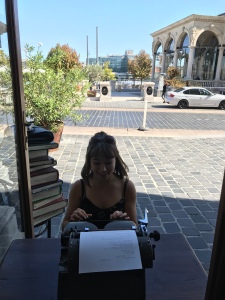If you walk straight down Oxford Road with Central Library at your back, you’ll pass the Palace Theatre on your way out of town. If you keep walking you’ll pass the Aquatics Centre, the RNCM and, if your legs aren’t tired yet, you’ll come to the Manchester Museum. If you walk a street across to the left, onto Upper Brook Street, and head south for a little longer, the straight road which you’ve hitherto traversed will be met at a 45-degree angle by an unassuming A-road. If you were to head down this street (Plymouth Grove, you’d note), if your feet weren’t too sore, you’d end up passing a pretty, detached house, painted in a pleasant pastel yellow, surrounded by a neatly-tended garden, with an impressive front entrance adorned by a small circular blue plaque.
Now, at this point, you might decide to jump on the bus home, or simply admire the building as you pass on your way to Tesco or the gym. You might even wonder in passing what it might once have been, or what it is now, or what the small circular blue plaque says.
But if you had a little time to spare, or were an especially inquisitive little soul, you might enter through one of the wide iron gates and pull the old-fashioned doorbell. You might scan the small circular blue plaque and wonder who Elizabeth Cleghorn Gaskell was, or what the ‘many other works’ which she penned, besides Cranford and Mary Barton, were, or you might simply think how jolly old she would have been now, noting that she died in 1865.
But, of course, you might not pause at the door. You might not even ring the doorbell, because, chances are, a smiling volunteer would have ushered you in from the cold by this point and suggested the handsome wooden hat stand as a convenient sport for your bulky coat and scarf. But you needn’t worry that you’re missing out – because they’d probably urge you to go back outside and give the doorbell a good tug, since it’s quite a novelty to ring the very same one which Charles Dickens did.
You might be quite intrigued by this point, and impressed by the grandeur of the house and its tasteful Victorian décor. You might be persuaded by the aforementioned cheerful volunteer to purchase a ticket (you’d probably be impressed that it’s only £4.95, or even £3.95 for concessions, and will last you the twelvemonth) and have a look around.
If you’re ready for elevensies, or you haven’t had lunch yet, you might head straight down to the quaint but spacious tea room, located in the former kitchen and servants’ quarters, and be charmed in equal measure by the sunny staff and splendid coffee and walnut cake.
But perhaps you’d choose to postpone this little indulgence and satisfy your curiosity as to the building first. In which case, you’d probably enter the morning room, and get acquainted with the basics of the Gaskell family and their time in Manchester. Some of Elizabeth Gaskell’s novels would probably sound familiar, and you might remember that BBC adaptation of North and South. Richard Armitage’s smouldering good looks might eclipse an in-depth memory of the intricacies of the plot, but you might recall the struggle between worker and master, and note the striking link with Manchester’s industrial past.
From there you’d probably pass into William Gaskell’s study, marvel at the walls of beautifully-bound Victorian novels and reference books – maybe even notice the latest addition, The Life of Sir Walter Scott in ten volumes – and hear from a well-informed and friendly volunteer all about William’s life as a Unitarian minister and teacher.
Next you’d probably step into the drawing room, and admire its delightful fireplace (the only original left in the house). You wouldn’t be able to touch the piano, but would learn about the Gaskell’s connection to Charles Hallé (founder of the Hallé orchestra) instead. You might note the portraits, side by side, of Mrs Gaskell and Charlotte Brontë, and learn more about their connection. You might even hear the funny anecdote about one of Charlotte’s visits to the Gaskells’ house, but you’d have to visit to find that out. Art lover or complete amateur, you might appreciate the paintings which adorn the walls, from foreign mountains to Florence Nightingale, and be amazed that Elizabeth Gaskell’s passport looked so very different from your own.
Then you’d wander through to the dining room, the place where bookworms and literature lovers really get their fill. You’d see the table at which Elizabeth Gaskell wrote, engage in speculation as to which seat she occupied, and hear more about her writing from yet another cheery volunteer.
I really couldn’t predict what might happen next. A stroll in the garden might take your fancy (as it so often did Elizabeth’s), or you might visit the upstairs exhibition. You might buy a book from the shop in the tearoom, or scurry off to the library to take out North and South, Mary Barton, Wives and Daughters, Cranford, Ruth and Sylvia’s Lovers all at once, inspired by your new-found Gaskell mania. You might decide to try that coffee and walnut cake which has been recommended in every room.
There’s really only one way to find out.
Here’s a link to their wonderful website if you need any more information before hastening down to Plymouth Grove – http://www.elizabethgaskellhouse.co.uk/, or feel free to comment with any Gaskell-related questions. (I had a wonderful time volunteering at this splendid hidden gem in the Easter holidays so will do my best to answer them.) Or you might want to check out their Twitter (https://twitter.com/GaskellsHouse) or Facebook page (https://www.facebook.com/ElizabethGaskellsHouse).
